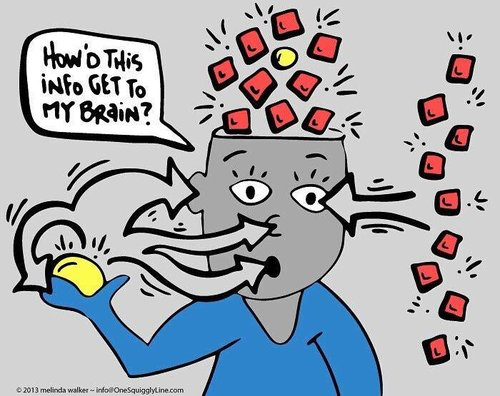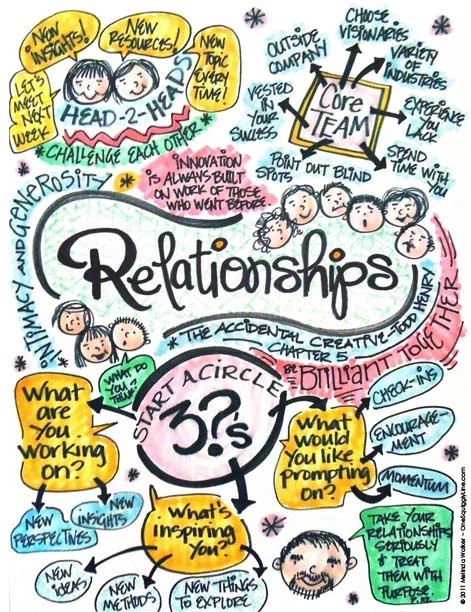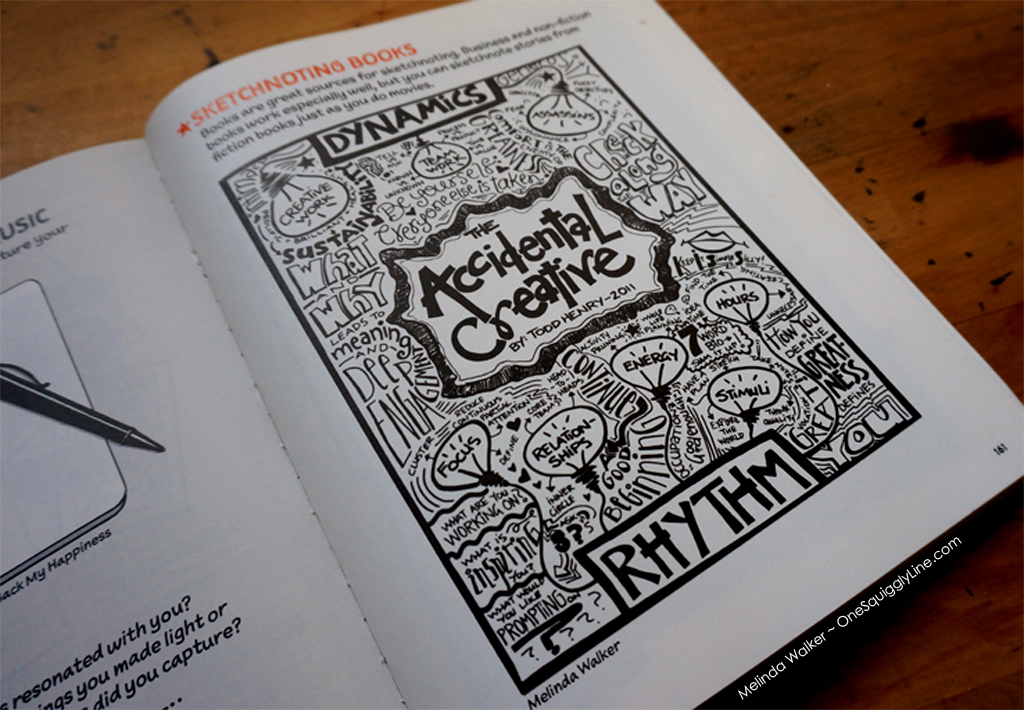People often think of taking visual notes while listening to a live presentation or maybe an audio file. But there's no reason why your notes from print materials can't be visual, too. Especially if you're studying. Or gathering information to write a longer paper. Or even reading a non-fiction book just for fun.
The visual notes above were created while reading chapter 5 of The Accidental Creative,by Todd Henry. One assignment in my grad program was to write a book review. Of course, that meant I had to actually read the book first! So, I created visual notes of each chapter as I went along. That made it much, much easier to see main themes as they emerged.
I had no intention of showing these to anyone when I created them. They were just how I kept track of the key points from each chapter. And I actually ended up "writing" the entire book review visually!
You can see then entire set in thisPinterest board.Because I hadn't planned on sharing them with anyone, I experimented with some things. Some I like better than others, but they all did the job of making my notes much easier to use later on...and the whole project way more fun!
Creativity: 10 Ways to Shake Things Up!
Take a cold shower
This will likely be an unfamiliar experience, allowing you to create new neural connections.
Make a new meal without a recipe
This will force you to be comfortable without all of the answers in front of you
Try a new hairstyle
A new change could inspire you!
Create a new outfit that you’ve never worn before
Mixing and matching will help you form new styles. A new outfit can give you a new vibe, which can inspire confidence.
Journal about your day
This reflection time will allow you to absorb what you’ve learned throughout the day. Journaling will also allow you to look back on old memories and see patterns in your life.
Take a new route that you haven’t taken before
This will give you a new perspective. This will take you out of auto-pilot mode, and force you to think in different ways.
Rearrange your room or living space
This can create a fresh environment and get you out of a routine feeling
Ask more questions
The more curious you are, the more you will learn.
Limit or eliminate social media for a day
You can use the extra time gained from eliminating social media to be more productive. You can spend this time in silence. It will likely be an unfamiliar experience.
Exercise your body and mind
Whether working out, doing yoga or meditating, this will allow your body and mind to relax and take a break from life.
Giving your mind a break allows creative ideas to flow naturally.
Hire me to shake things up for you!
Visual Thinking - The Artist's Mindset: An excerpt
“Art is not limited to what one can create with their hands - that is far from art. Art is taking an idea, an experience, an encounter or a thought, and making it somehow visible. This visible form can come in the way one dresses, sings, writes, shops, speaks, or listens to music.”
-Meredith Illig
Learn more about visual thinking
Creativity & Visual Thinking: Go for Quantity!
Creativity demands quantity. Creativity comes from being exposed to a lot of different stimuli. It comes from having a lot of different experiences. It’s being able to draw from each of these experiences, and the unique reservoir associated with it. When we have a lot of different experiences, we can continue to build upon new and old ideas with the wisdom we’ve gained.
In order to come up with a great idea, we need to have large quantity of ideas to pick and choose from, and experiment with. It’s easy to pick the first ideas that come to our mind, and it’s oftentimes the case that we stop after the first few ideas and fail to go further.
We need to open our minds to more ideas. We can’t stop at our first ideas. Our first ideas are typically generic, and already thought of before. The more ideas we come up with, and the more we suspend our judgement, the more novel our ideas are. We must stretch our minds to think further, and to suspend any judgement.
This is particularly helpful with brainstorming - of trying to come up with a good idea, whether for a work project or a personal project.
The creative mind is the mind that doesn’t stop at the first idea.
Visual thinking is a simple way to increase the amount of knowledge that sticks in your brain. And the more knowledge you have, the more building block you have to create with.
Contact me to bring the power of visuals to your next meeting, events, or project.
Creativity: We All Have It — Reignite Yours!
Think back to when you were a kid. Do you remember your personality? Do you remember any quirks you had?
And if you can’t remember that far back, think about the little kids you know, whether family, friends, or even strangers.
They all have one thing in common - they’re at the the most creative stage in their life.
Children are at a stage where they haven’t been conditioned to many routines and norms. They are completely themselves - unfiltered and raw.
...Always asking why
...Not caring too much of what others think about their appearance or their actions
...Saying whatever comes to mind
...Not holding back any ounce of laughter
As we grow older, eventually we don’t question as much
Eventually the routines of life become mainstream
Eventually our imagination grows stale
We hold back our laughter more and more
And eventually we lose the perspective of what could be in exchange for what is
Creativity gets taught out of us
Our teachers telling us to write in 12 pt. Arial font.
Our parents not having enough patience to answer all of our why’s.
Our own inflicted judgements
We become afraid of failure. Of messing up. Of saying the wrong thing. Of being judged.
To the point where we’ve lost ourselves in exchange for a mask that society has handed us.
We have unlearned creativity.
We all have the ability to be creative, but it's our job to learn it again.
Visual thinking is a great way to jumpstart your creativity, whether personally or professionally, alone or with a group. Simply watching someone else create something can inspire creative thinking and actions. Contact me to bring the power of visuals to your next event, meeting, or project and reclaim your creativity!
Visual Thinking & Visual Notes: Books
People often think of taking visual notes while listening to a live presentation or maybe an audio file. But there's no reason why your notes from print materials can't be visual, too. Especially if you're studying. Or gathering information to write a longer paper. Or even reading a non-fiction book just for fun.
The visual notes above were created while reading chapter 5 of The Accidental Creative, by Todd Henry. One assignment in my grad program was to write a book review. Of course, that meant I had to actually read the book first! So, I created visual notes of each chapter as I went along. That made it much, much easier to see main themes as they emerged.
I had no intention of showing these to anyone when I created them. They were just how I kept track of the key points from each chapter. And I actually ended up "writing" the entire book review visually!
You can see then entire set in this Pinterest board. Because I hadn't planned on sharing them with anyone, I experimented with some things. Some I like better than others, but they all did the job of making my notes much easier to use later on...and the whole project way more fun!
Visual Thinking & Creativity: It's Contagous!
There's a myth out there that highly creative people just sit around and wait for inspiration to strike. And while they wait, they really don't care about the real world.
Truth is, highly creative people know great ideas do not come from within. They come from connections made with something outside ourselves. Often, those connections are made with something created by another creative person.
That's why the highly creative notice, appreciate, and celebrate creativity wherever they find it. And they even seek it out. So if you'd like to be more creative, start appreciating creativity when you see it. You'll soon discover ideas really are all around you!
Visual Thinking Template: Evaluation Matrix
Visual thinking helps to make things clear. It's really important to see all options clearly when it comes time to make a decision. A matrix is a great (and easy) way to make it clear how your options stack up.
To use, write the names of four books at the top (by each of the four books!). Write your criteria in the boxes on the left. For example, "Is the topic interesting to me?" "Do I understand most of the words?" Use a happy or sad face to answer each question about each of the four books. Then it's easy to see the book that best meets the criteria - it has the most happy faces.
This evaluation matrix was created for use in elementary classrooms but can easily be adapted for adult use.
Sketchnotes: Published!
How does a very visual person write an academic paper? Visually, of course! This was the first page of a book review created as part of my master's program. While it has yet to appear in any scholarly journals, it has been published in something way more fun - The Sketchnote Workbook, by Mike Rohde.









